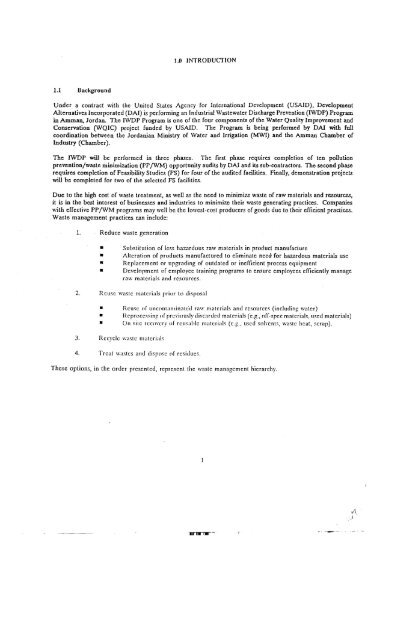Watcr Q!!alit\1 lmprovcmct1t at1() COf1scrvatiof1l'rojcct
Watcr Q!!alit\1 lmprovcmct1t at1() COf1scrvatiof1l'rojcct
Watcr Q!!alit\1 lmprovcmct1t at1() COf1scrvatiof1l'rojcct
You also want an ePaper? Increase the reach of your titles
YUMPU automatically turns print PDFs into web optimized ePapers that Google loves.
1.0 INTRODUCfION<br />
1.1 Background<br />
Under a contract with the United States Agency for International Development (USAlD), Development<br />
Alternatives Incorporated (DAI) is performing an Industrial Wastewater Discharge Prevention (IWDP) Program<br />
in Amman. Jordan. The IWDP Program is one of the four components of the Water Quality Improvement and<br />
Conservation (WQIC) project funded by USAID. The Program is being performed by DAI with full<br />
coordination between the Jordanian Ministry of Water and Irrigation (MWI) and the Amman Chamber of<br />
Industry (Chamber).<br />
The IWDP will be performed in three phases. The first phase requires completion of ten pollution<br />
prevention/waste minimization (PP/WM) opportunity audits by DAI and its sub-contractors. The second phase<br />
requires completion of Feasibility Studies (FS) for four of the audited facilities. Finally, demonstration projects<br />
will be completed for two of the selected FS facilities.<br />
Due to the high cost of waste treatment, as well as the need to minimize waste of raw materials and resources,<br />
it is in the best interest of businesses and industries to minimi7.c their waste generating practices. Companies<br />
"ith effective PP/WM programs may well be the lowest-cost producers of goods due to their efficient practices.<br />
Waste management practices can include:<br />
1. Reduce waste generation<br />
• Substitution of less hazardous raw materials in product manufacture<br />
• Alteration of products manufactured to eliminate need for hazardous materials use<br />
" Replacement or upgrading of outdated or inefficient process equipment<br />
• Development of employee training programs to ensure employees efficiently manage<br />
raw materials and resources.<br />
2. Rcuse waste materials prior to di.~posal<br />
•<br />
3. Recycle waste materials<br />
Reuse of unconlalllin:Jte'd raw m;Jlcri;J!s and rcsources (including water)<br />
Reprocessing of pre\'iomly discarded materi:l!s (e.g., off-spec materials, used materials)<br />
On sile reco\'ery of reusable materials (c.g., used soh'ents, wasle heat, scrap).<br />
4. Treat wastes alltl dispose of residues.<br />
These options, in the order presented, represent the waste management hierarchy.<br />
iI\<br />
)'<br />
1111118 In T

















